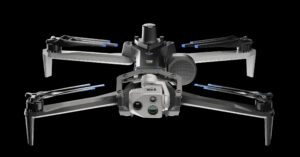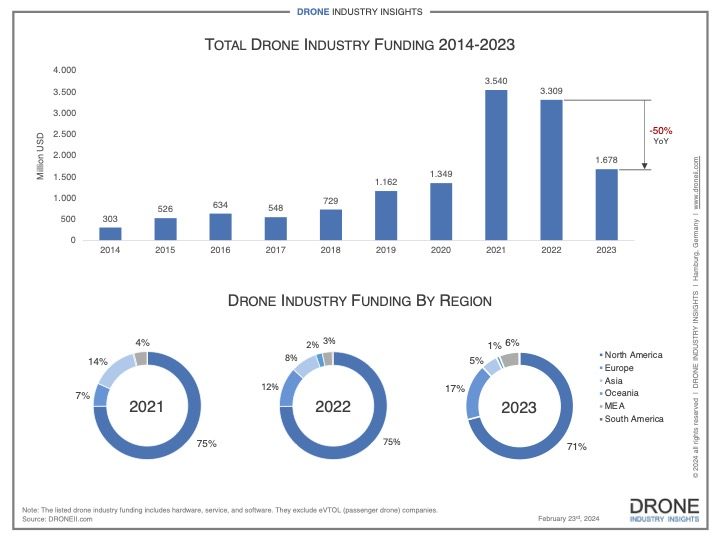Drone Industry Funding Sees Significant Drop in 2023: The Latest from Drone Industry Insights


Enterprise version of Skydio X10
Drone Industry Insights has published their latest report detailing the state of Drone Industry Investments. The research is an in-depth analysis: but one stark fact stands out in the summary. In the realm of drone industry funding, the year 2023 witnessed a notable downturn, marking a departure from the meteoric rise seen in previous years.
Data gleaned from investment infographics and the blog post by Zahra Lotfi reveals that the cumulative total of funding for drone companies worldwide in 2023 stood at US$1.7 billion. While this figure may appear substantial at first glance, it pales in comparison to the previous year’s total of US$3.3 billion, signifying a stark decline.

An analysis of funding patterns sheds light on several key factors contributing to this downturn. One significant aspect is the shifting landscape of venture capital investments, particularly in later-stage funding rounds. Across various industries, including drones, there has been a noticeable decrease in the value of such investments. This trend suggests that companies transitioning past the startup phase may encounter greater challenges in securing substantial financial backing.
Moreover, the landscape of initial public offerings (IPOs) and post-IPO deals presents a mixed picture. While the value of these transactions has more than doubled, indicating a positive trajectory for companies entering financial markets, there has been a reduction in the number of such deals compared to the previous year. This dichotomy underscores the nuanced nature of the funding landscape, defying simple categorization as wholly positive or negative.
Regionally, North America emerged as the primary beneficiary of drone company funding, capturing 71% of the global total. Major investments in companies like Zipline and Skydio bolstered the region’s position as a key player in the industry. However, the share of funding allocated to North America has declined since 2021, while Europe has seen a steady increase, accounting for 17% of global funding in 2023.
The distribution of funding across industry segments also offers insights into prevailing trends. Hardware companies continue to receive a higher percentage of investments, reflecting the significant costs associated with manufacturing drone platforms. Nevertheless, there has been a notable shift in funding towards drone service companies, surpassing investments in drone software companies—a reversal from the previous year.
As stakeholders ponder the implications of these funding dynamics, questions arise regarding the trajectory of the drone industry. Is the decline in funding indicative of a broader shift towards emerging technologies such as Advanced Air Mobility (AAM)? Or does it signify a natural progression as the industry matures? With these considerations in mind, stakeholders are poised to navigate the evolving landscape of drone industry funding, adapting strategies to capitalize on emerging opportunities and address underlying challenges.
Despite the stark difference in investment between 2022 and 2023, Lotfi sees room for optimism in the numbers:
“The economic shocks and major financial impact of the COVID-19 pandemic in 2020-2021 led to astoundingly high investments in drone technology (where investment values more than doubled). But if these outlier years are factored out, drone company funding would still show a continuous upward trend since 2017,” she writes. “Moreover, deep technologies such as artificial intelligence and machine learning are trending upward at an incredible rate, and these have a direct impact on drone technology. Perhaps these will also create a unique opportunity to invest in drone companies much like the pandemic did, except this time the regulatory progress will also be more palpable.”
Miriam McNabb is the Editor-in-Chief of DRONELIFE and CEO of JobForDrones, a professional drone services marketplace, and a fascinated observer of the emerging drone industry and the regulatory environment for drones. Miriam has penned over 3,000 articles focused on the commercial drone space and is an international speaker and recognized figure in the industry. Miriam has a degree from the University of Chicago and over 20 years of experience in high tech sales and marketing for new technologies.
For drone industry consulting or writing, Email Miriam.
TWITTER:@spaldingbarker
Subscribe to DroneLife here.


